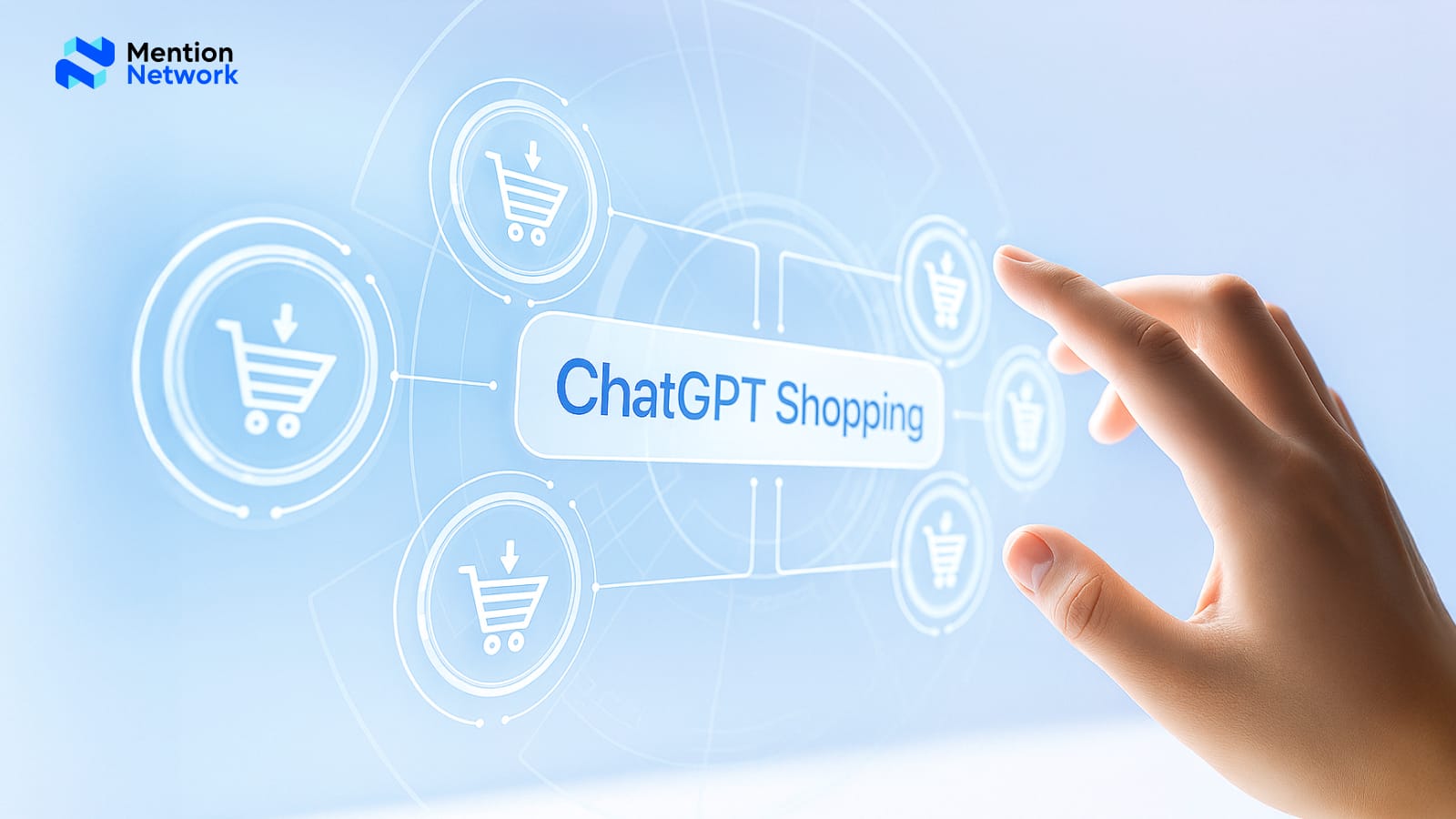How ChatGPT Shopping Changes the Future of Brand Discovery

The way people discover and buy products online is undergoing the biggest transformation since the birth of search engines. For decades, discovery started with a query typed into Google. But in 2025, that experience is being rewritten. Consumers now ask ChatGPT, Gemini, or Perplexity what to buy, and they trust the answer.
This shift marks the rise of ChatGPT Shopping, where AI assistants act as both search engines and storefronts. It is also where a new layer of competition begins: visibility inside AI-generated recommendations. To help brands understand this transformation, this guide breaks down how AI-driven shopping works, why SEO alone is no longer enough, and how AI Visibility tools like Mention Network help brands stay discoverable in this new era.
- ChatGPT Shopping Is the New Search: Discovery now begins inside AI assistants, not Google results.
- Zero-Click Commerce: Users buy directly from AI answers if your brand isn’t mentioned, you don’t exist.
- Trust Fuels Visibility: Consistent, verifiable data boosts inclusion in AI recommendations.
- GEO Over SEO: Optimization now means being understood and recommended by models, not ranked by algorithms
- Measure AI Share of Voice: Track how often your brand appears across ChatGPT, Gemini, and Perplexity to stay visible in generative commerce.
What Is ChatGPT Shopping?
ChatGPT Shopping is the natural evolution of search. Instead of showing a list of links, AI assistants generate answers that directly recommend brands and products, like a personal shopper powered by data. When a user asks, “What’s the best laptop for video editing?”, ChatGPT does not send them to a blog or retailer. It summarizes, compares, and recommends instantly.
This experience represents the Generative Commerce Layer, where AI models synthesize thousands of data points to deliver a final decision to the user. And every time the model generates an answer, it is deciding which brands exist in that context.
That is the new challenge: if AI does not mention your brand, you do not exist in the buyer’s conversation.
How ChatGPT Shopping Redefines the Discovery Phase in Digital Commerce
ChatGPT Shopping is not a marketplace or a web catalog. It is the point where intent, context, and model reasoning converge inside a single conversation. Instead of sending a user to ten websites, the assistant synthesizes competitive options, applies constraints like budget or brand values, and returns a short list or a single best pick. That synthesis is now the primary shelf space for many categories.

What Changes Inside the Customer Journey
Traditional search gave users choices. Generative AI gives users conclusions. This changes the dynamics of discovery in three key ways:
- Zero-Click Decision Making
In ChatGPT Shopping, users rarely click through to external sites. The assistant delivers the answer directly, meaning purchase intent and brand evaluation happen inside the chat. If your brand isn’t mentioned, you don’t even enter the consideration stage. - AI as the New Gatekeeper
Instead of ranking algorithms, we now face reasoning engines. ChatGPT, Gemini, and others weigh facts, tone, and contextual alignment to decide which brands deserve inclusion. Optimizing for these reasoning models is what chatgpt optimization aims to achieve making your brand “understandable” to AI cognition. - Trust as the New Brand Currency
Users trust AI because it appears objective. That perception gives immense power to generative models. Brands that maintain factual integrity and data consistency across the web earn higher trust scores internally within the model, boosting recall in AI answers.
Why This Matters For Performance Marketing And Brand
Traffic that used to touch your site during consideration may never arrive. Brand preference is now influenced earlier, often before a click. This does not eliminate SEO, but it makes building brand visibility inside AI assistants a parallel requirement. Measuring how often your brand is included, how it is described, and when rivals are preferred becomes a core analytics function.
How AI Decides Which Brands to Recommend
When ChatGPT or Gemini generates an answer that includes products or services, it follows a reasoning process rather than a random selection. The model evaluates a combination of data integrity, contextual fit, and trust signals to determine which brands deserve to appear. These variables are embedded in its training and reinforcement layers, meaning every mention is the result of statistical confidence, not coincidence.
- Factual Accuracy:
The model prioritizes data that is current, verifiable, and consistent across all known web sources. If your website lists one founding year and your Wikipedia or Crunchbase shows another, the model perceives uncertainty and may omit you entirely. Regularly updating structured data (Schema.org, JSON-LD) helps reinforce factual integrity. - Semantic Relevance:
AI interprets meaning rather than keywords. It analyzes whether your brand consistently aligns with the semantic clusters surrounding the user’s intent for example, “eco-friendly skincare,” “AI Visibility tools,” or “blockchain analytics.” The stronger and more repetitive these conceptual links are across credible sources, the more likely you are to surface. This is why chatgpt optimization focuses on clarity of brand positioning, not keyword density. - Authority Weight:
AI assigns higher confidence to brands frequently co-occurring with authoritative data sources such as Wikipedia, news outlets, or academic references. This co-occurrence functions like backlinks in SEO but instead of passing link juice, it passes trust probability. Earning citations in reputable databases and consistent mentions in reliable media helps increase your brand’s internal ranking inside AI reasoning. - Sentiment Context:
Tone analysis plays a surprisingly strong role. Positive reviews, credible user feedback, and neutral reporting strengthen the model’s confidence in recommending your brand. In contrast, polarized or misleading content can trigger lower weighting or even exclusion from generative recommendations.
This evaluation process is invisible to users but measurable. It is what Mention Network defines as the AI Visibility layer, the cognitive space where data accuracy, authority, and sentiment converge to determine which brands the model “remembers” and recommends. Tracking these variables through an ai search visibility tool allows marketers to quantify and improve their share of AI-driven recognition.
The New Marketing Metric: AI Visibility
In traditional SEO, success is measured by clicks and traffic. In generative commerce, success is measured by AI mentions and recall.

This metric, known as AI Visibility, captures how frequently and accurately a brand appears in generative responses. It replaces search rankings with something more fundamental: presence in AI reasoning.
| Old Metrics (SEO) | New Metrics (GEO) |
|---|---|
| Keyword Ranking | AI Mention Frequency |
| Click-Through Rate | Accuracy of Brand Description |
| Backlink Authority | AI Share of Voice |
| Organic Traffic | Recommendation Probability |
Without visibility across AI models, brands risk becoming invisible at the moment of purchase intent. Measuring and improving AI Visibility is now as essential as ranking once was in the Google era.
How Mention Network Helps Brands Compete
Mention Network is purpose-built to help brands measure, understand, and improve their visibility within AI ecosystems. It continuously tracks how often and in what context your brand appears in leading generative models such as ChatGPT, Gemini, Claude, and Perplexity, then transforms those raw occurrences into structured performance data. This enables brands to see how they are perceived and compared across the entire generative web.
The platform analyzes four key dimensions that define AI Visibility:
- Frequency: Measures how often your brand appears in AI-generated responses across prompts, industries, and contexts. Consistent frequency indicates the model “knows” your brand and can recall it reliably.
- Accuracy: Evaluates whether AI descriptions of your brand are factually correct, aligned with current data, and consistent across platforms. Even minor errors such as outdated pricing or misattributed features, can erode trust and reduce mentions.
- Sentiment: Assesses how AI represents your tone and reputation. Positive or neutral framing reinforces perceived reliability, while negative or uncertain language signals a credibility gap that needs correction.
- Share of Voice: Compares your visibility against direct competitors, revealing whether the model prefers your brand or others when answering relevant prompts.
By turning AI mentions into measurable data points, Mention Network bridges the gap between human perception and machine cognition. It gives marketers a precise view of how AI systems understand, describe, and recommend their brand allowing them to take informed action to strengthen building brand visibility and improve their ai visibility score over time.
What Brands Can Do Today
Brands can begin adapting to the ChatGPT Shopping era with three essential actions that lay the foundation for long-term AI visibility.
1. Audit Your AI Presence:
Start by searching your brand directly in ChatGPT, Gemini, or Perplexity. Observe how each model describes you what details it gets right, what it omits, and how it positions you relative to competitors. This simple exercise reveals your current AI reputation and identifies early gaps in factual accuracy and category alignment.
2. Unify Your Data:
Inconsistent data is the fastest way to lose trust in generative systems. Make sure your brand name, product details, and pricing match across your website, social profiles, databases, and media listings. Unified facts form the core of effective chatgpt optimization and raise your baseline ai visibility score.
3. Measure AI Visibility:
Use Mention Network to access an AI Visibility Report, which quantifies your mentions, sentiment, and accuracy across major LLMs. By translating abstract model behavior into clear analytics, this step turns AI visibility into a measurable performance metric.
The earlier you start measuring, the faster you can influence your brand’s position in AI-driven recommendations and build sustainable visibility through data integrity, not guesswork.
The shift from search results to AI-generated recommendations marks the beginning of a new discovery economy. ChatGPT Shopping is not just a trend, it is a structural change in how consumers interact with brands.
Visibility within this system is no longer about page rank. It is about trust, data clarity, and factual precision. Mention Network gives brands the visibility intelligence needed to stay present in the AI era, where every answer is an opportunity, and every omission is a lost sale.
Frequently Asked Questions (FAQ)
Q1: What exactly is ChatGPT Shopping?
A1: It is a new behavior where users ask AI assistants to recommend or compare products directly inside the chat interface, skipping traditional search results.
Q2: Why is ChatGPT Shopping important for marketers?
A2: Because AI now acts as both search engine and decision-maker. If your brand is not mentioned, you are missing an entire channel of consumer intent.
Q3: How do AI assistants decide which brands to recommend?
A3: They rely on factual consistency, semantic relevance, and association with trusted data sources. The better your brand data aligns across the web, the more likely AI will include you.
Q4: How can I measure my brand’s presence in AI answers?
A4: Through an AI Visibility tool like Mention Network, which analyzes your mentions, sentiment, and accuracy across ChatGPT, Gemini, and Claude.
Q5: What is the difference between SEO and GEO?
A: SEO optimizes for ranking on search engines, GEO (Generative Engine Optimization) optimizes for being mentioned and recommended by AI. Both are essential, but GEO defines the future of brand discovery.

